Over the last two years, Intel's mobile chip division has lost $7 billion while heavily subsidizing the manufacturing costs of Android Atom tablet makers. It now plans to phase out those generous incentives, which will make it more expensive for iPad competitors to dump cheap tablets into the market.
Apple has been selling tens of millions of iPads in competition with a series of loss leader giveaways from Samsung and regular fire sales of flop tablets, including the HP TouchPad, BlackBerry PlayBook, Motorola Xoom, Dell Streak, Microsoft Surface, Cisco Cius, HTC Flyer, Google Nexus and Amazon Kindle Fire.
At the same time, Intel has been spending billions to flood the market with cheap Android tablets using its Atom processor. All of this subsidized, clearance sale product dumping makes it quite incredible that Apple can sell any iPads at all, let alone remain the world's leading tablet vendor.This subsidized, clearance sale product dumping makes it quite incredible that Apple can sell any iPads at all, let alone remain the world's leading tablet vendor
ARM and a lag
Over the past four years, Intel has been paying netbook and tablet manufacturers to switch from ARM Application Processors to its own chipsets centered around its x86 mobile Atom processor.
These payments include co-marketing, extreme discounts on Atom chips, and payments to cover the costs of redesigning logic boards to accommodate Intel's Atom rather than ARM chips from companies including Nvidia and Qualcomm.
In February, Bernstein Research analyst Stacy Rasgon noted that Intel's subsidies, which the company refers to as "contra-revenues," amounted to about $51 per tablet, "which on the surface seems absurd," particularly because those Android "tablets are increasingly cheap models, mostly sub-$199," according to a report on Rasgon's note by Barrons.
Rasgon wrote, "Our analysis suggests that Intel will likely not be selling tablet chips in 2014 for much above costs, with gross margins approaching zero, even before adding rebates into the mix." She calculated that Intel's rebates to manufacturers in 2014 amounted to around $2 billion.
Intel reported mobile chip losses of $3 billion in 2013. Those losses increased this year; Morgan Stanley analyst Joseph Moore recently estimated that Intel's Mobile and Communications Group will lose $4 billion in 2014. That's an astounding $7 billion lost across two years, three years after Intel announced its partnership with Google to support Android.
"While we do expect that [Intel] phasing out tablet subsidies over the course of 2015 will cause modest reduction in losses, it could also blunt the company's momentum in tablets significantly," Moore wrote. "Eliminating these losses would require either massive revenue gains, or massive expense cuts, and we don't see a clear scenario for either of them."
Intel nostalgic for its x86 PC monopoly
While Intel is clearly trying to prop up its crumbling x86 1990-era WinTel empire, its current high subsidies are also an acknowledgment of Apple's increasing power. Apple's ability to sell high volumes of high-end products has given it the leverage to demand favorable prices and terms from its suppliers, including Intel.
Intel's massive Atom subsidies to other PC makers make it clear that the chip maker would prefer a return to the WinTel era, where it sold expensive chips to a wide variety of manufacturers who lacked any differentiation or price negotiation power, and where its proprietary chip design couldn't be easily copied.
Intel's co-rule with Microsoft effectively forced virtually every PC maker to adopt Intel chips and Windows software (with the notable exception of Apple) at whatever price the WinTel monopoly decided to charge.
Intel welcomed Apple's Macintosh to the world of x86 chips in 2006, but by 2010 the chip maker had created an UltraBook Fund aimed at getting PC manufacturers to produce machines that looked like MacBook Air clones. Intel also floated a copycat Mac mini design.
Intel's backstabbing style of partnership with Apple appears to have pushed the Mac maker toward investing in its own custom processors for iOS devices. Apple's hardware profits have since financed the development of new chip technology that is not only better than Intel's mobile Atom, but now threatening to rival the chip giant's mainstream desktop processors.
Apple's iPad busted the WinTel trust
Around 2008, Intel expected Apple to adopt its mobile x86 Silverthorne chips (later rebranded as Atom) for its new iOS tablet. However, when the iPad appeared in 2010, Apple instead used its own A4, a customized ARM chip that was also used to power iPhone 4 later that year.
At the beginning of 2011, Microsoft also snubbed Intel by showing off what would later be named Windows RT, a project to get Windows working on ARM chips— including the Qualcomm Snapdragon, TI OMAP and Nvidia Tegra chip families— in order to keep low end Windows PCs, netbooks, tablets and hybrid 2-in-1 devices competitive with Apple's increasingly popular iPad. Intel's Atom chips were clearly unable to match the A4 iPad's battery life.
Jilted by Microsoft, Intel subsequently rushed to support Google's Android 3.0 Honeycomb also in competition with iPad, offering makers fat subsidies for building Android tablets using Intel Atom chips.
Reversal of fortunes for WinTel
Working separately, Intel and Microsoft both failed spectacularly. Over the past two years, iPad sales have remained an empire, selling 70 million units per year. Windows RT ended up an unmitigated disaster.
Microsoft spent two years delivering Windows RT, then failed to support existing Windows software on ARM products like its own Tegra-powered Surface RT. When Apple moved Macs to PowerPC in 1994 and then Intel chips in 2006, it did the extra work required to support existing Mac applications on its new hardware, setting the expectation that Windows RT would, too.
Microsoft apparently thought that Windows was a valuable brand that people would go out of their way to buy even if it didn't work in the minimally utilitarian fashion that people expect from products bearing a Windows logo.Microsoft apparently thought that Windows was a valuable brand that people would go out of their way to buy even if it didn't work in the minimally utilitarian fashion that people expect from products bearing a Windows logo
Intel's Android partnership resulted in the Atom-powered 2012 Motorola RAZR i phone, which Android fans hailed as a new savior until it mysteriously disappeared. While failing to find interest among phone makers, Intel has pushed hard to force Atom into Android tablets, at great expense.
Intel's Atom chips are approaching shipments of 40 million this year, after reaching 10 million in 2013. However, Atom shipment growth has come directly from Intel's liberal subsidies; shipments are expected to collapse as soon as Intel stops paying subsidies, as it plans to do next year.
Intel CEO Brian Krzanich "is laser focused on [reaching] 40 million tablets," Intel's chief financial officer Stacy Smith stated during a conference call with analysts in April, as reported by CNET.
Krzanich said 80-90 percent of tablets Intel was subsidizing were Android, the rest ran Windows. "The majority is in $125 to $250 range," he detailed.
Intel's mobile Atom chips are cheaper and less profitable than its conventional x86 desktop-bound processors, so much of the expensive progress in selling Atom-based netbooks and tablets has come out of the flesh of Intel's more lucrative PCs shipments, a sort of "friendly fire" casualty stemming from its war on iPad.
Rather than continuing to spend billions on Atom subsidies, Intel now plans to license its x86 Atom, 3G and LTE baseband IP to Chinese fabless chip designers including Rockchip, Spreadtrum and RDA Microelectronics, following a licensing model similar to ARM or Qualcomm.
Those partnerships expect to launch new "SoFIA" chips by the middle of next year, which Intel hopes it won't have to continue to subsidize. However, that move will also result in Intel collecting far smaller IP royalty payments while its new chip design partners earn most of the money in selling finished chips to tablet manufacturers.
Intel's Atom bombs the benchmarks
It's also not clear why Intel seems to think Atom is competitive with ARM. "We don't take any competition lightly, but we're confident that our Intel Atom (Bay Trail) processors will continue to be the performance and performance per watt leader," an Intel spokesman was cited as saying in a report by EETimes.
However, Intel's Bay Trail Atom Z3745 used in Lenovo's Yoga Tablet 2 Pro (a top scoring Android tablet) delivers CPU benchmarks closer to a two year old iPad 4, while its "Intel HD" graphics deliver the worst GPU benchmarks of any recent tablet we tested, and about one quarter the scores of iPad Air 2.
Intel apparently thinks that Intel is a valuable brand that people will go out of their way to buy even if it doesn't work in the minimally utilitarian fashion that people expect from products bearing a Intel logo.
 Daniel Eran Dilger
Daniel Eran Dilger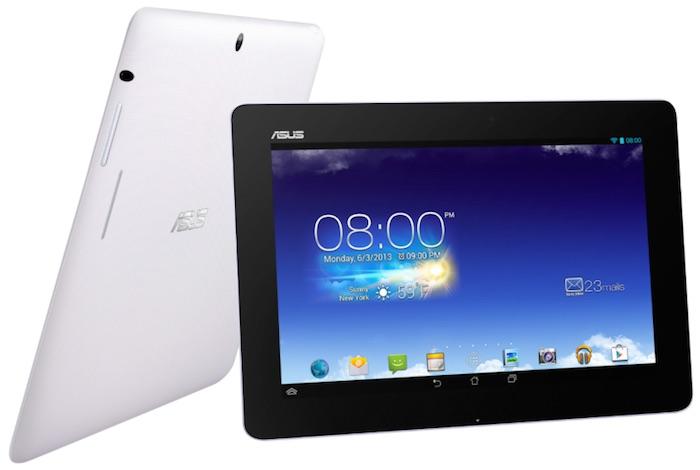
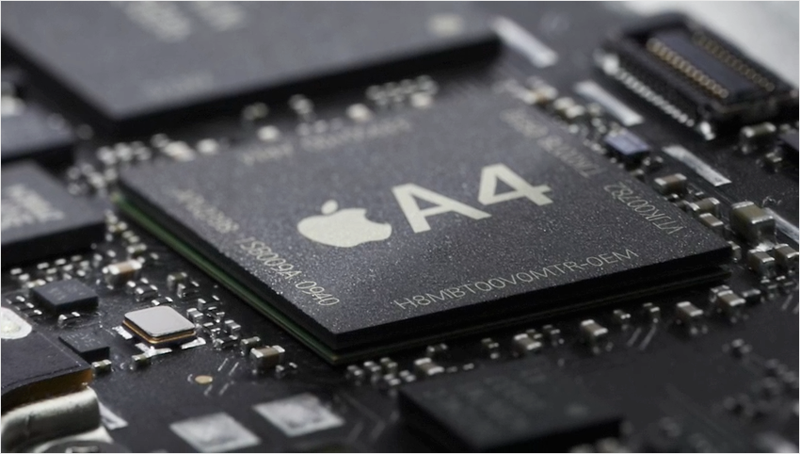
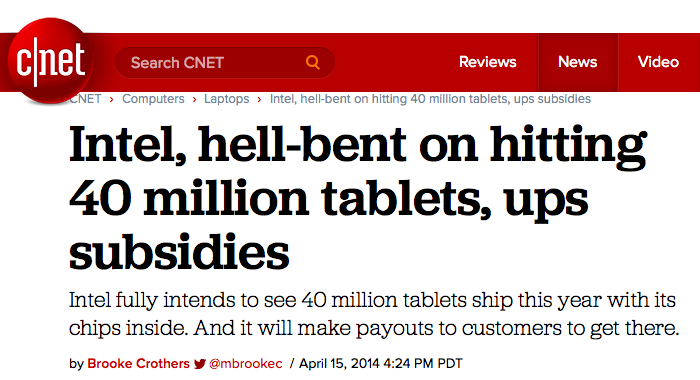
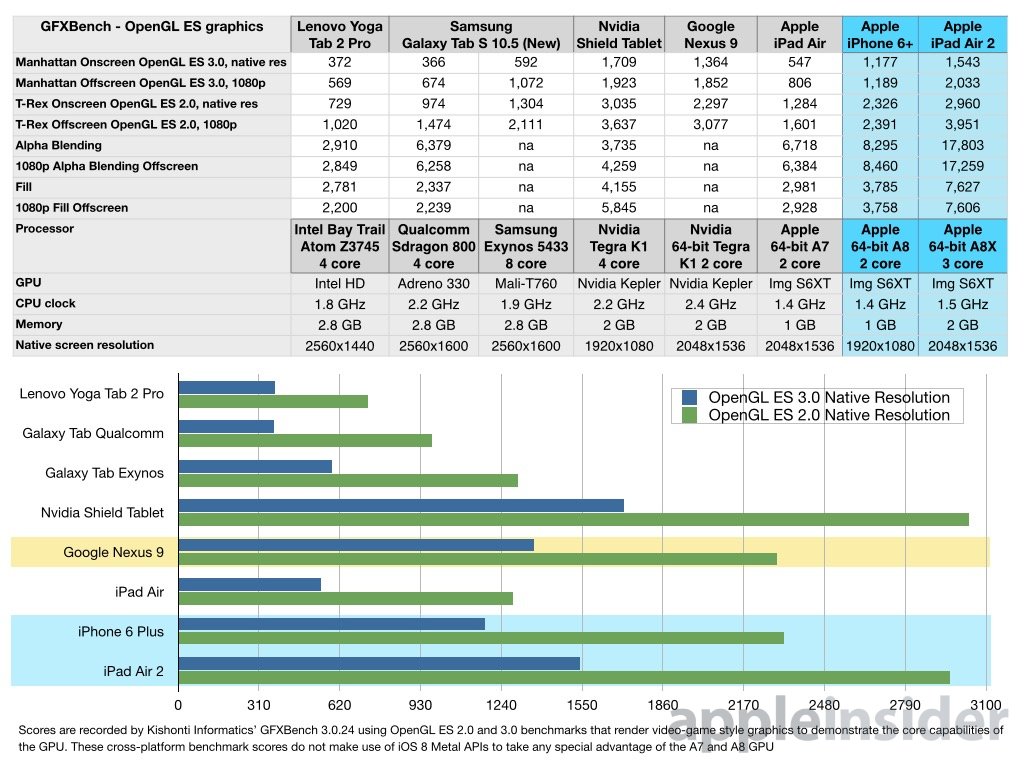







-m.jpg)






 Charles Martin
Charles Martin
 Christine McKee
Christine McKee
 Wesley Hilliard
Wesley Hilliard
 Malcolm Owen
Malcolm Owen
 Andrew Orr
Andrew Orr
 William Gallagher
William Gallagher
 Sponsored Content
Sponsored Content


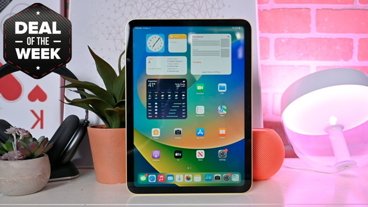





217 Comments
Nothing to see here. Just more click bait
Nice one, two punches, keep keep up the good work.
[quote name="hill60" url="/t/183451/after-losing-apples-ipad-business-intel-has-bled-7-billion-while-heavily-subsidizing-cheap-x86-atom-android-tablets#post_2640204"]Nice one, two punches, keep keep up the good work.[/quote] Yup, Intel has performed so poorly that Apple has given up with them in the Macbook Air, Macbook Pro , Mac Pro, iMac 5k, and the Mac mini .. Oh wait EVERY MAC USES INTEL
.. Oh wait EVERY MAC USES INTEL
This is the mobile market, which is much larger than the PC market.
Apple is selling ~50M iOS devices with Ax vs the ~5M Intel Macs it sells.
Intel wants to be in mobile, which is why it is paying OEMs to use its stuff. Even that isn't working. And that's pretty sad.
Apple doesn't have to pay people to use iPads, or even Apple Maps.
[quote name="AppleInsider" url="/t/183451/after-losing-apples-ipad-business-intel-has-bled-7-billion-while-heavily-subsidizing-cheap-x86-atom-android-tablets#post_2640199"]Apple has been selling tens of millions of iPads in competition with a series of loss leader giveaways from Samsung and regular fire sales of flop tablets, including the HP TouchPad, BlackBerry PlayBook, Motorola Xoom, Dell Streak, Microsoft Surface, Cisco Cius, HTC Flyer, Google Nexus and Amazon Kindle Fire. [/quote] Google Nexus a "flop tablet". Seriously.